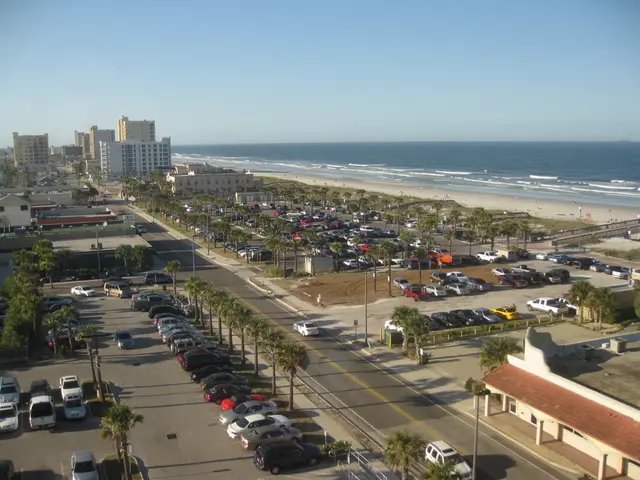Heavy rains inundate Mexico City's central square, Zócalo, prompting airport shutdown
Flooding in Mexico City: Heavy Rain and Neglected Drainage Systems
Mexico City experienced severe flooding on Sunday, August 2021, due to a combination of intense rainfall and neglected drainage systems. The heavy rainfall, which was the most intense of the 2021 rainy season in the capital, resulted in significant inundation of major roads and public squares, disrupting transportation and causing widespread urban chaos.
The National Water Commission (Conagua) put 37 pumps into operation to remove 74,000 liters per second of water, but the rainfall during the storm was significantly above the historical average for the period, with more than 84 millimeters of rain recorded in the Zócalo alone. This excessive rainfall, exacerbated by climate change but mostly due to decades of neglect in urban water management, lack of drain maintenance, and settlements built in high-risk areas, led to the collapse of parts of Mexico City's deep drainage system.
The Benito Juárez International Airport was closed for around four hours due to the storm, affecting 104 flights and 14,892 passengers. The Metropolitan Cathedral and nearby jewelry stores in the historic center were also affected by the floodwaters. Flooding was reported at the Balbuena General Hospital and the Gregorio Salas Hospital in the historic center, prompting firefighters to help move patients from the Balbuena hospital during the flood.
The flooding was not caused by an extraordinary natural event alone. The drains were not cleaned or repaired ahead of the season despite available advance warnings, and improper urban planning led to vulnerable neighborhoods suffering the most during heavy rains. Residents regularly face these challenges every rainy season, pushing cars through floods, building improvised barriers, and using buckets to drain water.
The city's Plan Tlaloque was activated when the heavy rain began in the capital. The second-highest level, a red alert, was issued for several other boroughs. Specialized equipment was sent to Nezahualcóytl and Ecatepec to support the population and mitigate the effects of the rain. More than 200 personnel from the Water Management Ministry were deployed to respond to the flooding in various parts of Mexico City.
Despite the efforts of Conagua and other agencies, the flooding in Mexico City during the storm was a stark reminder of the need for improved urban water management and drain maintenance. The city's drainage systems are designed for average amounts of rainfall, but the rain on Sunday was extraordinary in its volume and intensity, highlighting the need for a more resilient infrastructure to protect the city from future floods.
City officials, including Mayor Claudia Sheinbaum, called on residents to be careful with the disposal of their trash to ensure that it doesn't end up in stormwater drains, which is the main thing that affects Mexico City's drainage systems. The flooding in Mexico City during the storm serves as a reminder that while natural events such as heavy rainfall can cause damage, the extent of the damage can be significantly reduced with proper planning and maintenance.
- The weather on Sunday, August 2021, in Mexico City was exceptionally heavy, contributing to the catastrophic flooding.
- Apart from the weather, the lack of cultural attention towards environmental science and proper urban planning has also been a significant factor in the flooding.
- The business sector was significantly affected, as the Benito Juárez International Airport was closed, causing delays for 104 flights and 14,892 passengers.
- The general news coverage of the event included discussions about the urgent need for effective climate-change strategies to improve Mexico City's drainage systems, especially considering the impact of such events on public health and infrastructure.






